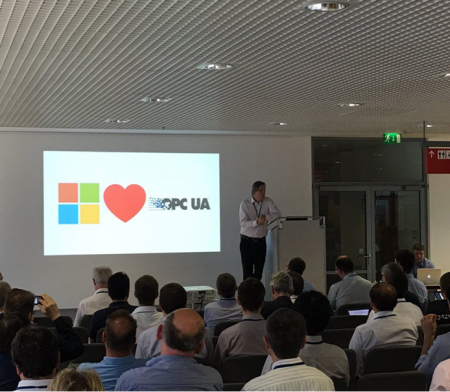Microsoft and the OPC Foundation announced at Hannover Messe in May 2016 extended support for OPC UA across Microsoft’s IoT offerings, with deep integration of OPC UA in Azure IoT Suite and Windows 10 IoT. The technology supporting this integration was made available by Microsoft to the OPC Foundation open-source on GitHub shortly afterwards. At the time we said we’re just getting started and we meant it.
 Just a short month afterwards, at OPC Day Europe in June 2016 we marked the next milestone in our Industry 4.0 open platform journey with the news that Microsoft will contribute a platform-independent .NET Standard reference stack to the OPC Foundation, which we made available open-source on GitHub shortly afterwards. This stack has the benefit of working on all common software platforms in market today, allowing the creation of OPC UA clients, servers and of course “OPC Publishers” for sending Pub/Sub-compatible sensor telemetry data to the cloud on Windows Vista, 7, 8, 8.1, 10, iOS, Linux and Android platforms, vastly reducing engineering effort and maintenance cost for OPC products. Of course this reference stack also supports running OPC UA applications directly in the Azure cloud, enabling completely new business models, i.e. OPC UA Software as a Service (SaaS) offerings for Industry 4.0 applications.
Just a short month afterwards, at OPC Day Europe in June 2016 we marked the next milestone in our Industry 4.0 open platform journey with the news that Microsoft will contribute a platform-independent .NET Standard reference stack to the OPC Foundation, which we made available open-source on GitHub shortly afterwards. This stack has the benefit of working on all common software platforms in market today, allowing the creation of OPC UA clients, servers and of course “OPC Publishers” for sending Pub/Sub-compatible sensor telemetry data to the cloud on Windows Vista, 7, 8, 8.1, 10, iOS, Linux and Android platforms, vastly reducing engineering effort and maintenance cost for OPC products. Of course this reference stack also supports running OPC UA applications directly in the Azure cloud, enabling completely new business models, i.e. OPC UA Software as a Service (SaaS) offerings for Industry 4.0 applications.
In August 2016, Microsoft contributed an “OPC Publisher” sample to the OPC Foundation’s ANSI-C reference stack open-source on GitHub, completing our lineup of OPC Publisher samples for sending Pub/Sub-compatible sensor telemetry data to the cloud on all common platforms, even if the platform is so small that it doesn’t run a full OS. Have a look at https://github.com/opcfoundation and try them out!
As we continue our support for manufacturers with their Industry 4.0 initiatives using OPC UA, these developments are an important step forward in terms of digitally assisting production, maintenance, and service workers across all device form factors, regardless of platform, with broad access to relevant insights and collaboration tools. This has the potential to vastly increase the share of OPC UA-enabled devices, open up scenarios in new verticals that leverage powerful capabilities in the cloud like analytics and machine learning, and therefore create benefits for all of us across a broad ecosystem.
 It’s been a busy Summer, but we’re far from done yet! Stay tuned for more announcements from Microsoft, our industry partners and the OPC Foundation at an industrial automation conference near you in the not-so-distant future.
It’s been a busy Summer, but we’re far from done yet! Stay tuned for more announcements from Microsoft, our industry partners and the OPC Foundation at an industrial automation conference near you in the not-so-distant future.
-Erich Barnstedt
Principal Software Engineering Lead Azure IoT
Microsoft Corporation
There is also an accompanying press release. Here is an excerpt:
At Microsoft, we are committed to standards and interoperability in IoT. This is particularly important for Industrial Internet of Things (IIoT) deployments. In these IoT environments, we see OPC UA as a critical standard for ensuring interoperability between a broad set of manufacturing processes and equipment, spanning decades of investment for many companies.